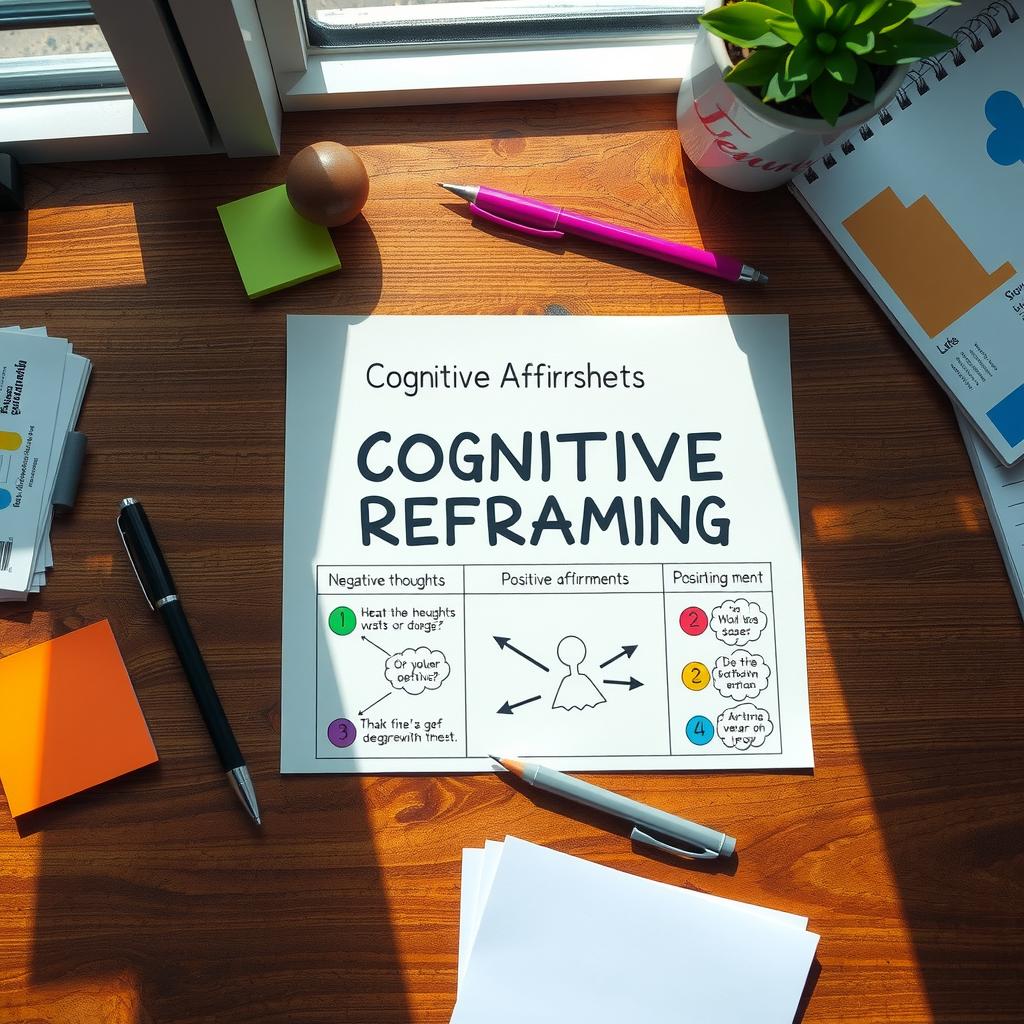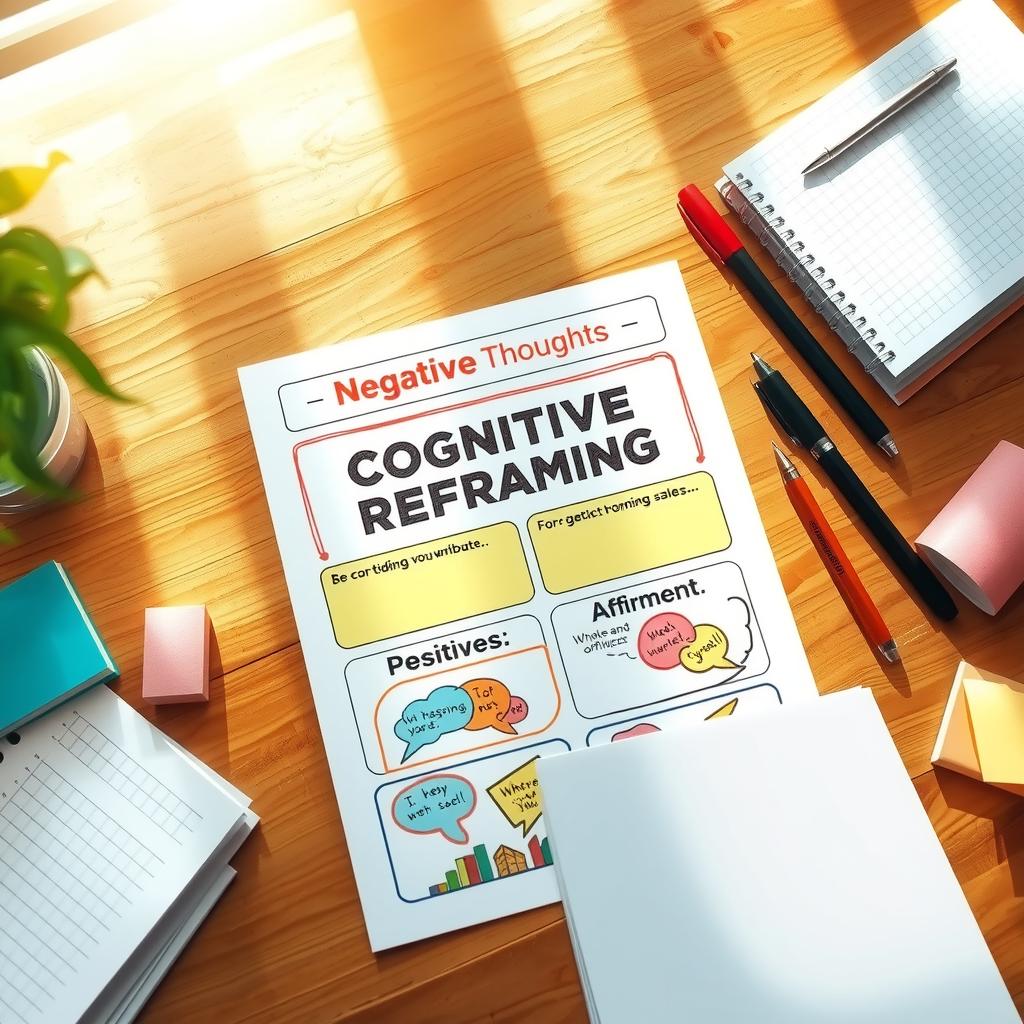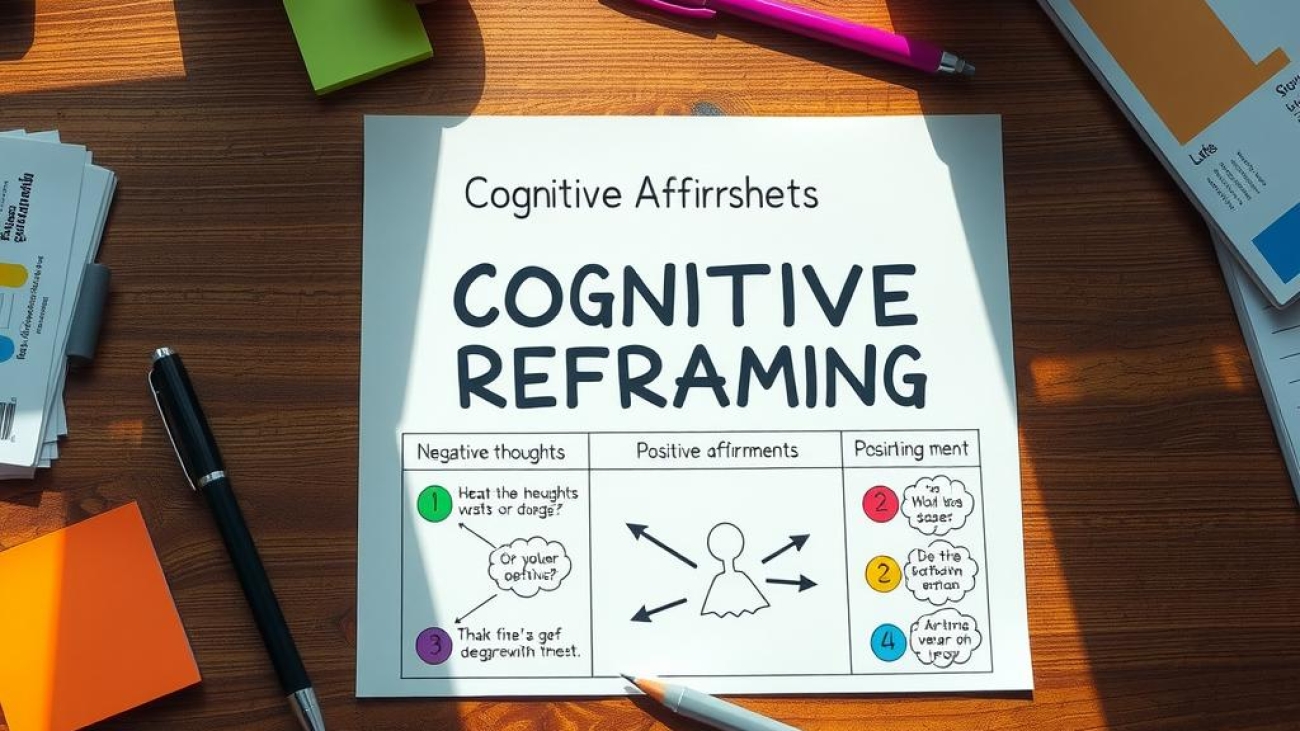In a world where stress and anxiety often cloud our thoughts, individuals frequently find themselves ensnared in a cycle of negative thoughts that can hinder their emotional well-being. These pervasive thought patterns not only affect mental health but can also seep into various aspects of daily life, impacting relationships, productivity, and overall satisfaction. Fortunately, the realm of cognitive therapy offers valuable tools to combat this issue through techniques like cognitive reframing. One effective way to implement these strategies is through specially designed cognitive reframing worksheets that guide users in shifting their perspectives.
The core value of these worksheets lies in their ability to facilitate awareness and transformation of negative thinking. By encouraging individuals to explore alternative viewpoints, they open the door to healthier thought processes which are crucial for effective stress management. Whether it’s challenging irrational beliefs or recognizing cognitive distortions that amplify distressing emotions, cognitive reframing worksheets serve as practical aids in navigating this journey toward better mental health.
Imagine having a structured approach at your fingertips—one that prompts reflection on harmful beliefs while simultaneously introducing constructive alternatives. This article aims to delve deeper into how utilizing cognitive reframing worksheets can empower readers by providing actionable steps toward breaking free from damaging thought cycles. Readers will discover not only the mechanics behind cognitive therapy but also how incorporating these resources into daily life fosters resilience against negativity.
By understanding the significance of cognitive reframing and utilizing thoughtfully crafted worksheets, individuals can reclaim control over their thoughts and enhance their emotional landscape. In an era marked by increased mental health challenges, embracing such strategies becomes essential for cultivating lasting well-being. As we explore further into this topic, it becomes clear: transforming one’s mindset is not just beneficial; it’s an achievable goal with tangible resources available today.

Key points:
-
Empowerment through Cognitive Reframing: The use of cognitive reframing worksheets enables individuals to challenge their negative thoughts, leading them toward a more empowered mindset. By systematically identifying harmful thought patterns, these worksheets serve as an essential tool in cognitive therapy, fostering emotional well-being and resilience.
-
Structured Reflection for Clarity: Each worksheet provides structured prompts that encourage users to reflect on their personal experiences related to distressing situations. This process not only aids in pinpointing specific triggers for negativity but also promotes effective stress management by facilitating deeper understanding of one’s emotions and reactions.
-
Long-term Change and Insight Development: Engaging with cognitive reframing worksheets fosters lasting change by equipping individuals with strategies that promote mental health improvement. Through the exploration of complex feelings associated with challenges or setbacks, users often gain new insights about themselves, paving the way for healthier coping mechanisms and ultimately transforming their outlook on life from limitations to possibilities.

Understanding Cognitive Reframing: The Path to Mental Clarity
A Shift in Perspective for Enhanced Emotional Well-Being
Cognitive reframing is a powerful technique within cognitive therapy that holds significant promise for individuals grappling with negative thought patterns. This therapeutic approach involves identifying and challenging distorted thoughts, allowing individuals to replace unhelpful beliefs with more balanced perspectives. By utilizing cognitive reframing worksheets, one can systematically analyze their thought processes, uncovering the roots of anxiety or stress while fostering healthier responses. For instance, when faced with a setback at work, instead of succumbing to feelings of inadequacy—a common negative thought—individuals can learn to reframe this experience as an opportunity for growth and learning. Such shifts not only alleviate immediate emotional distress but also pave the way toward long-term mental health improvements.
Breaking Down Negative Thought Patterns
Understanding how negative thoughts operate is crucial in the journey towards mental clarity. These ingrained patterns often stem from past experiences and societal influences that shape one’s self-perception and worldview. Through consistent practice of cognitive reframing techniques detailed in cognitive reframing worksheets, individuals can break these cycles by recognizing triggers that elicit destructive thinking. For example, someone might habitually think “I always fail” after experiencing one mistake; however, reframing this into “I am capable of learning from my mistakes” encourages resilience and fosters a more supportive internal dialogue. This process not only enhances self-esteem but also supports effective stress management strategies necessary for maintaining overall emotional well-being.
The Role of Cognitive Therapy in Personal Growth
Cognitive therapy emphasizes the importance of understanding thought patterns as they relate to emotions and behaviors. By engaging regularly with cognitive reframing worksheets, individuals can cultivate awareness about how specific thoughts influence their mood and actions daily. As they reflect on situations where they’ve felt overwhelmed or defeated, clients are guided through exercises that encourage them to evaluate evidence supporting their negative beliefs versus those suggesting alternative viewpoints. This evaluative process diminishes the power held by harmful narratives while empowering individuals to embrace more constructive interpretations—a vital step toward achieving personal growth and improved mental health outcomes.
Strategies for Incorporating Reframing Techniques
Incorporating cognitive reframing techniques into daily life requires intentional practice alongside structured tools such as cognitive reframing worksheets designed specifically for various scenarios—ranging from workplace challenges to personal relationships. One effective strategy includes setting aside time each day dedicated solely to reflecting upon recent experiences through a reflective lens encouraged by these worksheets; this helps reinforce positive changes over time while making it easier during moments when negativity arises unexpectedly throughout one’s day-to-day activities.
Adopting mindfulness practices alongside regular use of these resources further bolsters resilience against stressors encountered daily.
Embracing Change Through Cognitive Reframing
Ultimately, embracing change is integral for anyone seeking enhanced emotional well-being via cognitive reframing methods rooted deeply within established psychological principles like those found in cognitive therapy frameworks aimed at reshaping dysfunctional beliefs surrounding oneself or others around them.
With commitment paired together alongside reliable support systems—including comprehensive materials like cognitive reframing worksheets—individuals find themselves equipped not only with new skills but also transformed perspectives enabling healthier interactions across all areas within both personal lives & professional environments alike leading ultimately towards enriched fulfillment amidst life’s complexities!

Understanding Cognitive Reframing Worksheets
A Practical Approach to Transforming Thought Patterns
Cognitive reframing worksheets serve as a valuable tool in the realm of cognitive therapy, aiding individuals in identifying and reshaping harmful thoughts into constructive beliefs. These worksheets guide users through a structured process that encourages self-reflection and critical thinking about their negative thoughts. The first step involves recognizing specific negative thoughts that arise during stressful situations or emotional turmoil; this may include feelings of inadequacy or hopelessness. By documenting these thoughts on the worksheet, individuals can gain clarity on recurring thought patterns that impact their mental health.
Next, the worksheet prompts users to evaluate the validity of these negative beliefs critically. This stage is crucial as it allows for an exploration of evidence supporting or contradicting these thought processes. For instance, if someone believes they are failing at work due to one missed deadline, they can examine instances where they have succeeded in their job responsibilities. This examination helps highlight distortions in thinking and paves the way for developing more balanced perspectives.
Once users identify flawed reasoning behind their negative emotions, they can move on to formulate alternative beliefs using guided questions provided within the cognitive reframing worksheets. These questions encourage positive affirmations and realistic assessments based on past experiences rather than unfounded fears or assumptions. By actively engaging with this process, individuals not only reshape detrimental thought patterns but also enhance their overall emotional well-being.
Finally, incorporating regular use of cognitive reframing worksheets into one’s daily routine proves beneficial for ongoing stress management and personal growth. Consistently revisiting one’s feelings and challenging them fosters resilience against life’s challenges while promoting adaptive strategies for coping with stressors effectively.
Enhancing Emotional Resilience Through Structured Reflection
The utilization of cognitive reframing worksheets offers an insightful pathway towards improved mental health by empowering individuals to take control over their internal dialogue. Each time a user interacts with these tools, there lies an opportunity not just for short-term relief from distress but also long-term development of healthier mindsets. As participants become familiar with navigating through various scenarios depicted on these sheets—whether related to personal relationships or professional pressures—they gradually build confidence in managing adverse feelings.
Moreover, incorporating practical exercises like journaling alongside cognitive reframing enhances its effectiveness further by allowing deeper introspection beyond initial surface-level responses captured during worksheet activities. Journaling serves as an excellent complement whereby insights gained from reflecting upon one’s experiences add layers to understanding how certain belief systems originate and evolve over time.
In conclusion, integrating cognitive reframing worksheets into everyday practices cultivates both awareness around negative thought cycles while simultaneously equipping users with actionable steps toward creating positive change within themselves—ultimately fostering lasting improvements across multiple facets such as emotional resilience and mental fortitude throughout life’s unpredictable journey.
The Power of Cognitive Reframing
Cognitive reframing is a transformative technique that can significantly enhance emotional resilience and improve overall mental health. By altering the way individuals perceive negative thoughts, this approach empowers them to shift their perspective on challenging situations. The process involves recognizing cognitive distortions—patterns of thinking that lead to negative emotions—and consciously adjusting these thought patterns to foster a more positive outlook. For example, instead of viewing failure as an insurmountable obstacle, one might reframe it as an opportunity for growth and learning. This shift not only helps in managing stress but also promotes emotional well-being over time.
Research has demonstrated that engaging with cognitive reframing worksheets can facilitate this critical process by providing structured exercises designed to guide individuals through various scenarios where reframing could be beneficial. These worksheets encourage users to identify their automatic negative thoughts and challenge them with evidence-based reasoning, fostering healthier thought processes aligned with cognitive therapy principles. When individuals regularly practice these techniques, they develop greater awareness of their thought patterns—a key ingredient in building emotional resilience.
The long-term benefits associated with cognitive reframing extend beyond immediate stress relief; they contribute profoundly to sustained mental health improvement. As people learn to recognize the transient nature of their emotions and the influence of perception on reality, they become better equipped to handle life’s inevitable challenges without succumbing to anxiety or despair. Over time, this newfound skill leads not only to improved coping mechanisms but also enhances one’s ability to form deeper connections with others through increased empathy and understanding.
Moreover, cultivating an attitude centered around cognitive reframing encourages proactive engagement in self-care practices that bolster mental wellness—such as mindfulness meditation or journaling—further supporting emotional stability during turbulent times. By integrating tools like cognitive reframing worksheets into daily routines, individuals cultivate a mindset geared towards positivity and resilience rather than defeatism.
In essence, embracing cognitive reframing allows for significant personal growth by reshaping how experiences are interpreted and responded to emotionally. Such changes create ripple effects throughout various aspects of life—from professional interactions influenced by enhanced stress management abilities to personal relationships strengthened through improved communication skills rooted in empathetic understanding. Ultimately, adopting these strategies fosters a nurturing environment where emotional well-being thrives amidst adversity—a testament to the lasting impact that effective cognitive interventions can have on one’s life journey.
In today’s fast-paced world, individuals often grapple with persistent negative thoughts that can overshadow their daily experiences. This cycle of self-doubt and anxiety not only affects one’s emotional well-being but also complicates effective stress management. To combat these detrimental thought patterns, the practice of cognitive reframing emerges as a valuable tool. By utilizing structured resources like cognitive reframing worksheets, individuals can learn to challenge and reshape their perspectives on distressing situations.
These specialized worksheets are designed to guide users through the process of identifying harmful thought patterns, encouraging them to reinterpret these thoughts in a more positive light. Each worksheet presents structured prompts that facilitate reflection on personal experiences, allowing individuals to pinpoint specific triggers for their negativity. Engaging with these cognitive reframing tools encourages deeper articulation of emotions and fosters resilience against future stressors. As people work through the exercises offered in the worksheets, they discover new insights about themselves that contribute significantly to enhancing their mental health.
The impact of using cognitive reframing worksheets goes beyond merely addressing isolated instances of negativity; it empowers individuals by providing them with practical strategies aimed at long-term mental health improvement. Participants break down complex feelings associated with challenges or setbacks into manageable components, leading them toward healthier coping mechanisms over time. Through systematic engagement with these resources, users take tangible steps towards reclaiming control over their mental landscape—shifting from a mindset filled with limitations to one brimming with possibilities.
FAQ:
Q: How do cognitive reframing worksheets help combat negative thoughts?
A: Cognitive reframing worksheets assist by guiding individuals through identifying harmful thought patterns and encouraging them to view situations from a more positive perspective.
Q: Can anyone use cognitive reframing techniques effectively?
A: Yes, anyone seeking relief from overwhelming negative thoughts or looking to enhance emotional resilience can benefit from engaging in cognitive therapy practices like using worksheets designed for this purpose.
Q: What is the overall goal of employing cognitive reframing in daily life?
A: The primary aim is to transform detrimental thought patterns into constructive beliefs that improve overall emotional well-being and foster effective stress management strategies.

Add a Comment